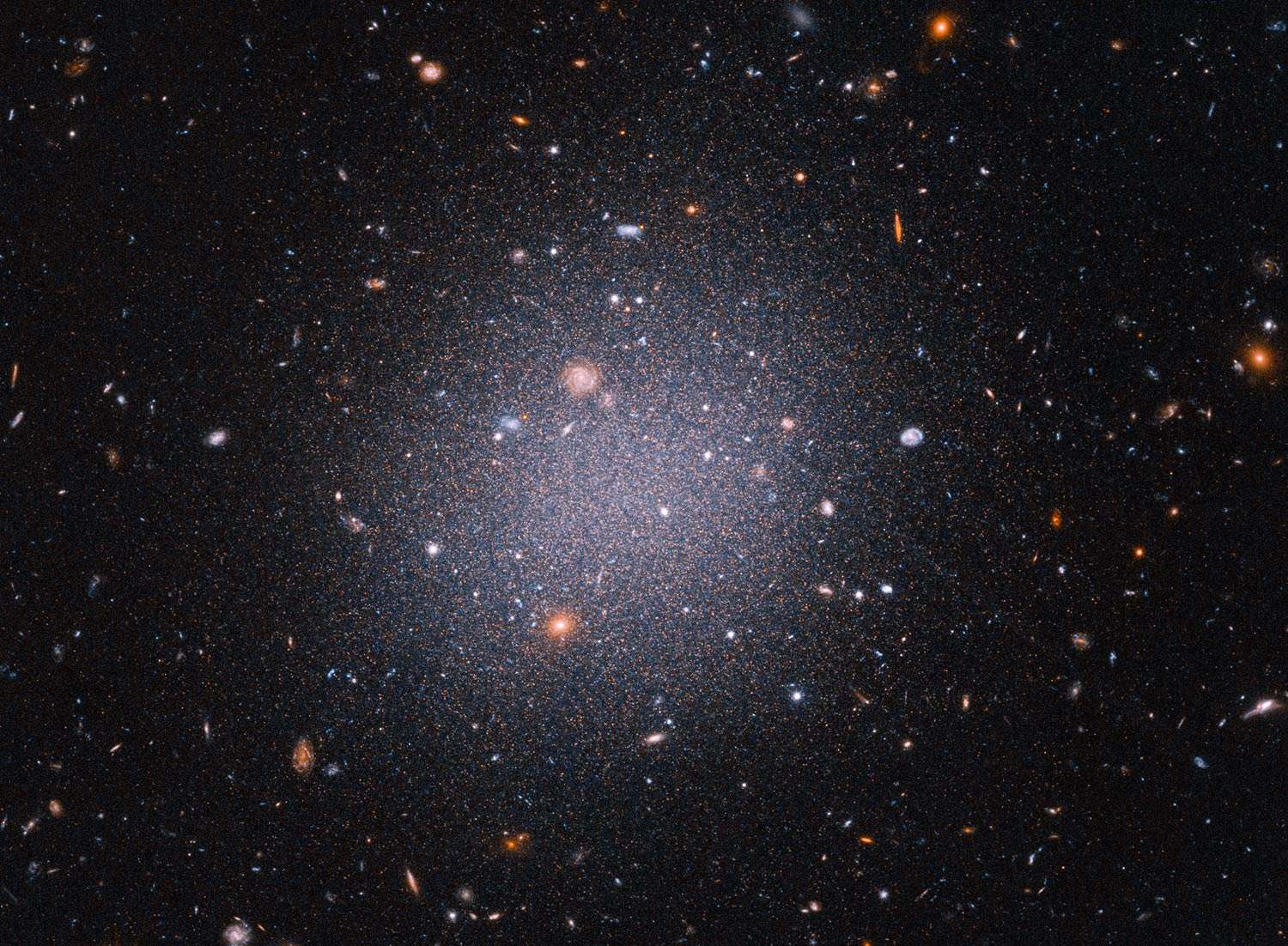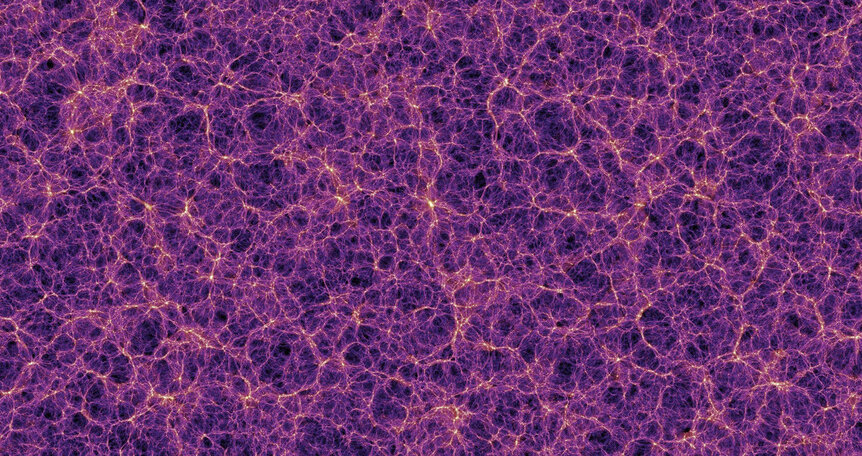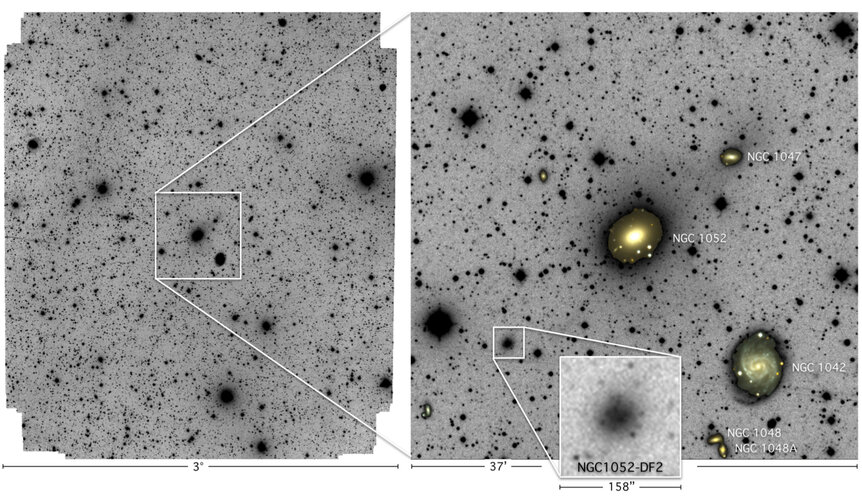Create a free profile to get unlimited access to exclusive videos, sweepstakes, and more!
If all galaxies have dark matter, why don't these two? Astronomers are following clues to find out.
Their dark matter may have been stolen by bigger galaxies.

In 2018, astronomers faced a fundamental problem: A group mapping relatively nearby galaxies found two very small ones that apparently were totally lacking in dark matter.
I know that sounds a little esoteric, but it's as shocking to astronomers as finding human bones next to dinosaur bones in a dig would be to a paleontologist. They shouldn't be there.
Dark matter is a huge part of the way we understand the Universe is structured, and finding galaxies without them is not just weird but contrary to the standard models used. It really threw the community into a tizzy.
But now another team of astronomers thinks they have the answer, or at least the first big step to the answer: Simulations of how galaxies grow and behave reproduce ones without dark matter, and in fact they look an awful lot like the ones actually seen [link to paper]. It's not clear yet why exactly the simulations reproduce them, but the galaxies in the sim have some characteristics in common that lead a way to figuring this all out.
Dark matter is the term we hang on a kind of matter that dominates the Universe but is completely invisible. The kind of matter we're made out of — protons, electrons, and so on — have mass, interact with each other, and also interact with light, making them visible.
But starting over a century ago astronomers started to suspect there might be invisible matter out there, and in the 1960s and '70s astronomer Vera Rubin showed conclusively that this dark matter exists, and it also totals 5 to 6 times the mass in the Universe as what we call "normal" matter. In other words what we call "normal" matter is in the minority.
It outmasses normal matter, but also, importantly, it doesn't interact with normal matter either. Put a big cloud of normal matter gas in space and it will collapse, but it will also feel pressure as the particles bump into each other, and heat up as well. Dark matter won't; it'll just orbit around doing its thing and ignoring the normal matter except via gravity.
Once we realized it existed, dark matter played a much bigger role in how we understood the Universe. We think it actually was the first material to start to collapse gravitationally after the Big Bang, forming huge filaments tens of millions of light years long — we call this the cosmic web. Normal matter than became attracted to that and started forming galaxies as it condensed, using the dark matter framework like scaffolding.
So galaxies formed in the midst of all that dark matter, and attracted the dark matter to them gravitationally. Today, we see all galaxies surrounded by dark matter haloes, detected through their gravitational influence on the stars, gas, and dust inside the galaxy.
And, in fact, most small galaxies have an overabundance of dark matter relative to normal matter. That's because massive stars blow fierce winds of gas, and exploding stars blast huge amounts of materials into space. These small galaxies don't have enough gravity to hold on to this normal matter, so it's lost to intergalactic space. Dark matter doesn't interact with normal matter through things like gas pressure, so that stuff blows right past them. In the end, you're left with a galaxy that still has its initial dark matter, but with far less normal matter, so the ratio of dark to normal matter is very high.
No one expected to find any exceptions. But.
In 2000, astronomers were mapping the sky around the big galaxy NGC 1052, and found two extremely faint galaxies apparently orbiting it. Called NGC 1052-DF2 and -DF4, these are small, faint galaxies barely visible. It took some time to figure this out, with some really fun twists and turns along the way, but what they discovered is that the total masses of these two galaxies were equal to the masses of the stars in them. In other words, they were made completely of stars, with no dark matter at all!
Which, the standard model of cosmology and galaxy formations, tells us is not possible.
One idea came up that a special kind of dark matter might solve the problem, but now another solution has arisen.
We know a lot about the physics of gravity, gas flow, star formation, and a lot of other pieces of how galaxies form and behave. This physics can be written as a series of equations that interact with each other, and those can be plugged into a computer to simulate how galaxies are born and behave over time. The physics is... complicated, but some relatively new code called Feedback In Realistic Environments has been very successful in creating simulated galaxies that look and behave very much like how we see real galaxies out in the Universe going about their business.
A team of astronomers looking at the code found an anomaly though. Seven, really: Seven small galaxies in their simulations appeared to have plenty of matter in the form of stars, but very little to none in the form of dark matter! They named these galaxies after seven Cherokee clans: Bird, Blue, Deer, Long Hair, Paint, Wild Potato and Wolf — in a lovely blog post outlining the work, the lead author notes he has indigenous ancestors and ends his writing talking about colonialism and assimilation, and is worth your time to read.
Looking at these odd simulated galaxies carefully, they discovered that all of them were inside the haloes of dark matter of nearby large galaxies, and not only that, they had all recently passed, cosmologically speaking, right through those big galaxies, very close to their centers. Technically speaking, all seven had passed within 5% of the radius of the dark matter haloes from the galactic center, which is really plunging right through their hearts.
Somehow, these interactions are stripping away the dark matter while keeping the normal matter intact. The problem at the moment is it's not clear why. The astronomers published because the results are startling and important, but they're still working on the why. The working hypothesis is that stars tend to have circular orbits in these galaxies, but dark matter, whatever it is, would be on elongated orbits — because it doesn't interact with itself or normal matter, dark matter doesn't feel any pressure to circularize its orbit. This means it's farther out from the center and more easily stripped by the bigger galaxies tides.
If this is the case — if — then the curious case of the dark-matterless small galaxies will be solved. The simulations predict that 30% of all massive galaxies — like our own, the Milky Way — should have at least one small satellite galaxy without dark matter. That's a prediction that can be observationally tested, though it's hard. Those galaxies are faint and it's hard to measure their masses. But it's possible, so we may have more data soon to see if it supports or refutes this hypothesis.
I'll add that another galaxy, AGC 114905 also appears to lack dark matter, but is also isolated in space. so there's still more to this issue to figure out.
As we have to say a lot when it comes to cutting edge science: Stay tuned. No doubt more news will soon be on its way.




























